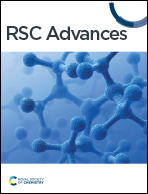Nitrogen-doped carbons derived from cotton pulp for improved supercapacitors†
Abstract
Supercapacitors have a rapid charge/discharge rate, long lifespan, high stability, and relatively acceptable cost, showing great potential in energy storage and conversion applications. However, the current cost-effective carbon-based electrodes have limited application owing to their low specific capacitance and unsatisfactory stability. In this regard, we herein prepare nitrogen-doped carbons by carbonizing a mixture of cotton pulp (CCP) and melamine to improve the specific capacitance by integrating pore (mesopore) and surface (oxygen-containing groups) modification with defect engineering via the carbonization process. Furthermore, the structural and morphological features of the resultant nitrogen-doped carbons are confirmed by various characterization techniques. Excitingly, the specific capacitance for nitrogen-doped CCP (CCPN1) with a 1 : 1 weight ratio of CCP and melamine is 642 F g−1 at a current density of 0.5 A g−1 in a three-electrode system, surpassing that of the reported carbon analogues and most metal-based materials to date. The stability test suggests that the specific capacitance of CCPN1 is maintained over 150 F g−1 at a current density of 2 A g−1 even over 5000 cycles. Therefore, the reported nitrogen-doped carbons from cotton pulp exhibit improved specific capacitance and stability, providing a new cost-effective carbon-based material for application in the energy storage field.



 Please wait while we load your content...
Please wait while we load your content...